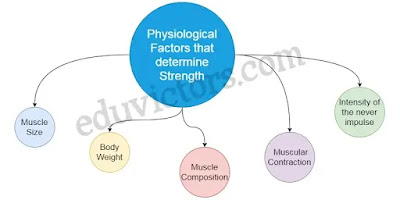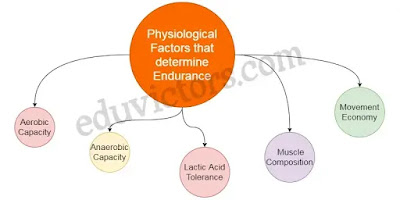Physiological Factors Determining Components of Physical Fitness (Q and A)
Chapter: Physiology and Injuries in Sports
Class 12 Physical education
Questions and Answers
Question 1(MCQ): How many physiological factors that determine physical fitness?
(a) Two
(b) Four
(c) Five
(d) Three
Answer: (b) Four
Question 2: Name the four factors that determine physical fitness?
Or
What are the four components of physical fitness?
Answer: Four factors are:
⑴ Strength
⑵ Speed
⑶ Endurance
⑷ Flexibility
Question 3: Define Physical fitness.
Answer: Physical fitness is your ability to carry out tasks without fatigue.
Question 4: Discuss the physiological factors, determine the strength as a component of physical fitness?
Answer:
1. Muscle size: Bigger and larger muscles can produce more force. Males have larger muscles than females so the size muscles and strength can be improved with the help of weight training.
2. Bodyweight: The heavier individuals are stronger than the individuals who are lighter for example the heavier weight lifters than the Gymnastic or other games players.
3. Muscle composition: The muscles which have more percentage of fast-twitch fibres can produce more strength while the slow-twitch fibres are not capable to contract faster but they are capable to contract for a longer duration. The percentage of fast-twitch fibres and slow-twitch fibres is genetically determined and can not be changed through training.
4. Muscular Contraction: Skeletal muscle contractions help in maintaining the body: posture, joint stability and heat production (thermoregulation of the body).
5. Intensity of the never impulse: When a stronger nerve impulse from central nervous system excites more number of motor units, the muscles will contract more strongly or it can side that the muscle will produce more force or strength.
Question 5: Discuss the physiological factors, determine the endurance as a component of physical fitness.
Answer:
1. Aerobic capacity: It includes oxygen intake, oxygen uptake, oxygen transport and energy reserve
2. Anaerobic capacity: It covers storage in the body of ATP and CP (phosphagen stock), buffer capacity in muscles, lactic acid accumulation and endurance of lactic acid
3. Max Volume of Oxygen Intake (VO2 max). This is the quantity of oxygen, which active muscles use during exercise in one minute.
Question 6: Discuss how physiological factors determine flexibility?
Answer:
1. Muscle strength:
The muscle should have a minimum level of strength to make the movement, especially against the gravity or external force.
2. Joint structure:
There are different types of joint in the human body, some of the joints intrinsically have a greater range of motion than others. For example. The ball and socket joint of the shoulder has the greatest range of motion in comparison to the knee joint.
3. Internal environment:
The internal environment of athlete influences the flexibility. For example-warm bath increases body temperature and flexibility whereas 10 minutes outside stay at 10°c temperature reduces the body temperature and flexibility.
4. Injury:
Injuries to connecting tissues and muscles can lead to thickening or fibroin on the affected area. Fibrous tissues are less elastic and can lead to limb shortening and lead to reduce flexibility.
5. Age and gender:
Flexibility decreases with the advancement of age. However, it is trainable. It can be enhanced with the help of training, as strength and endurance are enhanced. Gender also determines flexibility. Females tend to be more flexible than male.
6. Active and sedentary lifestyle:
Regular activities enhance flexibility, whereas inactive individual loses flexibility due to the soft tissues and joints shrinking and losing extensibility.
7. Heredity:
Bony structures of joints length and flexibility of the joint capsules and surrounding ligaments are genetical and can be altered by stretching programs.
Q7: Define endurance.
Answer: Endurance: Endurance is the ability of the body to work for a long time without getting fatigued. or The ability to sustain a physical activity over a longer period of time resisting fatigue is called Endurance.
Q8: What are the different types of endurance?
Answer: Types of endurance are:
(i) Aerobic endurance
ii) Anaerobic endurance
(iii) Speed endurance
(iv) Strength endurance
Q9: Define explosive strength/power.
Answer: Explosive strength is the ability to overcome resistance with high speed. It is a combination of strength and speed abilities. Explosive strength is generally used in sprint starts, Weight-lifting, Shot-put, Hammer throw, Long jump, High jump, Triple jump etc.
Q10: What does speed stands for in physical fitness.
Answer: Speed is the ability to resist fatigue and to sustain stamina.




No comments:
Post a Comment
We love to hear your thoughts about this post!
Note: only a member of this blog may post a comment.